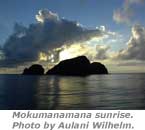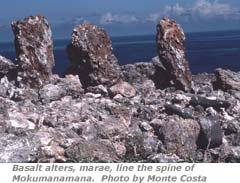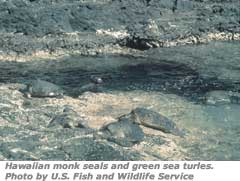|
You
are here: /main/about/mokumanamana
Necker
Island
(Mokumanamana)
 About
155 miles northwest of Nihoa lies Mokumanamana, a small basalt
island that is 1/6 square km, or 46 acres, in size. Although
the island is the second smallest of the NWHI, it has the
second largest surrounding marine habitat (almost 385,000
acres). Large offshore areas include Shark Bay on the north
side, West Cove and Northwest Cape as well as miles of shallow
reef to the southeast. About
155 miles northwest of Nihoa lies Mokumanamana, a small basalt
island that is 1/6 square km, or 46 acres, in size. Although
the island is the second smallest of the NWHI, it has the
second largest surrounding marine habitat (almost 385,000
acres). Large offshore areas include Shark Bay on the north
side, West Cove and Northwest Cape as well as miles of shallow
reef to the southeast.
Mokumanamana
is known for its numerous wahi pana (religious places) and
mea makamae (cultural objects). Fifty-five cultural  places
are known, of which 33 are religious, 17 are shelter caves,
and 2 sites are of unknown function. These cultural sites
are thought to date primarily before the habitation sites
on Nihoa Island were abandoned in the eighteenth century. places
are known, of which 33 are religious, 17 are shelter caves,
and 2 sites are of unknown function. These cultural sites
are thought to date primarily before the habitation sites
on Nihoa Island were abandoned in the eighteenth century.
Because
the island is small, dry, and has little soil suitable
for
agriculture, Hawaiians probably traveled to Mokumanamana
from Nihoa and other Hawaiian Islands primarily for religious
purposes.
It has also been theorized that the shrines which line the
spine of the island may have been used for navigational
purposes during the great trans-pacific voyages of the
early Hawaiians and Polynesians. In addition to constructing
shrines, Hawaiians made ki'i pohaku
or stone
human images
while
on Mokumanamana.
More than 11 of these stone ki'i are known. Other activities
that took place on the island are indicated by the production
and use of stone adzes, grindstones, stone bowls, and fishing
tools.
In
1786, Compte de La Pérouse, a French explorer, visited
Mokumanamana and named it "Necker Island" after
Jacques Necker, the finance minister under Louis XVI. In 1857,
Kamehameha IV sent Captain John Paty to claim Mokumanamana
for the Kingdom of Hawai`i. His claim was contested until
1894, when the island was annexed by Hawai`i's Provisional
Government.
The
Tanager Expedition visited Mokumanamana in 1923-24 and to
conduct biological and cultural research. Members of the Native
Hawaiian organization Hui Mälama I Nä Küpuna
O Hawai`i Nei visited Mokumanamana in 1997 to rebury ancestral
human bones that were removed from the island in the 1920s.
Terrestrial
animal life on Mokumanamana includes the blue gray noddy,
land snails, wolf spiders, bird ticks, and 15 endemic insects.
 Marine
life includes gray reef sharks, manta rays and sixteen
species of stony corals. Hawaiian monk seals are seen on
the island's rocky shores. A great abundance and diversity
of sea cucumbers, sea urchins, and lobsters are found in
Shark Bay. Little coral life exists in the shallow areas
due to the constant wave action that scours the underwater
basalt yet Mokumanamana is the most easterly island in
the Hawaiian archipelago where table corals, Acropora
spp.,
are found. Most reef life is found in holes and elevated
areas protected from the currents. Below the shallow reef
are extensive deeper "shelves" that extend many
miles from the island, especially to the southeast. These
broad offshore areas are used for commercial fishing and
a large percentage of the gray snapper (uku, Aprion
virescens)
landed in the state comes from these shallow banks. Marine
life includes gray reef sharks, manta rays and sixteen
species of stony corals. Hawaiian monk seals are seen on
the island's rocky shores. A great abundance and diversity
of sea cucumbers, sea urchins, and lobsters are found in
Shark Bay. Little coral life exists in the shallow areas
due to the constant wave action that scours the underwater
basalt yet Mokumanamana is the most easterly island in
the Hawaiian archipelago where table corals, Acropora
spp.,
are found. Most reef life is found in holes and elevated
areas protected from the currents. Below the shallow reef
are extensive deeper "shelves" that extend many
miles from the island, especially to the southeast. These
broad offshore areas are used for commercial fishing and
a large percentage of the gray snapper (uku, Aprion
virescens)
landed in the state comes from these shallow banks.
Visiting
Mokumanamana is permitted only for scientific, educational
and cultural purposes in order to protect its significant
natural and cultural resources. Approval must be given by
the U.S. Fish and Wildlife Service and is mostly granted to
those doing cultural and scientific activities.
<<back
-- next>>

 Ask
About It! Ask
About It!
Questions
from Kehau Enos, Hauula Elementary School, 9/10/02
Replies and translation by Bonnie Kahape'a
Aloha mai! Pehea 'oe me na po'e 'aukai? Makemake na keiki e
maopopo ina hiki ia 'oe ke huli a loa'a/noi'i paha no na pane
o keia mau ninau:
1.
Aia na honu ma laila? Ina 'ae, loa'a ia lakou na "tumors?"
Are
there any turtles there? If so, do they have tumors?
I ka makou ike huaka'I I Nihoa a
me Mokumanamana, ua ike makou I na honu nui a me na honu iki.
'Ae, wahi a kekahi, loa'a no kekahi o lakou I ka ma'i. I ka
po'akolu, I Mokupapapapa (French Frigate
Shoals) ana makou. Ma ia aina no, noho 90% o na honu Hawaii
ma laila. Hanau 'ia na honu I ia aina a hele lakou I na mokupuni
ewalu o Hawaii a ho'I akula lakou I ko lakou one hanou a hanou
akula lakou.
During our trip to Nihoa and Mokumanamana,
We saw big turtles and small turtles. And Yes, according to
one person, some turtles do have tumors. On Wednesday, we
will be going to Mokupapapapa (French Frigate
Shoals). On this island, 90% of Hawaii's green sea turtles
hatch here, go to the main Hawaiian islands, and return here
to lay eggs of their own.
2. Nui ka 'opala i loko o ke kai ma laila?
Is
there lots of trash there?
'Ae, ua 'ike makou I ka 'opala ma ka aekai ma Nihoa
a me Mokoumanamana a me ka 'opala e lana ana I ke kai. Wahi
a ka lohe, e nui aku ana ka 'opala ma na moku e hiki mai ana
ma ia huakai.
Yes, we saw some trash on the shore and tidal area on Nihoa
and Mokumanamana and trash floating in the ocean. According
to what I heard, we will see more evidence of trash as we
move up the island chain.
3. 'Oi aku ka maika'i o ke ea i laila?
Is
the air better there?
I kuu mana'o, 'Ae, pa maila ma makani o ka moana a hau'oli
no au.
As for me, yes, the ocean breezes blow and I am Happy.
4. He aha ke 'ano o na mea kanu i laila?
What
kind of plants are there.
Ma Nihoa, loa'a ka loulu Nihoa. Ma
ia wahi wale no! Ma Mokumanamana, loa'a 'elima mea kanu Hawaii,
o ka ohai 'oe o ka ihi 'oe, o ka akulikuli oe, o ke kakonakona
'oe, o ka 'aweoweo 'oe?
At Nihoa, the is an endemic Nihoa
Loulu palm. On Mokumanamana, there are only five plants, all
are native. The ohai, the ihi, the akulikuli, the kakonakona,
and the aweoweo.
5. Aia na manu HawaiŽi ma laila?
Are
there any Hawaiian birds there?
He elua manu Hawaii ma Nihoa. 'O
ka Nihoa miller bird kahi manu kaka'ikahi loa.
Nihoa has two endemic land birds.
The Nihoa Miller bird is very rare.
6. Aia na "non-native" mea ma ka 'aina ma laila?
Are
there any non native things there? Ma ka mokupuni o Mokumanamana,
'a'ohe mea 'e ma laila he wahi nani loa a maoli no.
On Mokumanamana, All the plants and birds are NATIVE.
'O ia wale no i keia la...na ke Akua e ho'opomaika'i ia 'oe
me na 'aukai 'e a'e. A hui hou e ku'u tita! :) kehau me na
keiki o ka papa alaka'i.
Aloha e na keiki mai ke ala polohiwa a kane! He maika'I wale
keia huaka'I. Ua pa ia ka naau I ka nani o ko kakou kupuna.
E lekauila hou mai ia'u! Ke Akua pu me 'oukou.
|